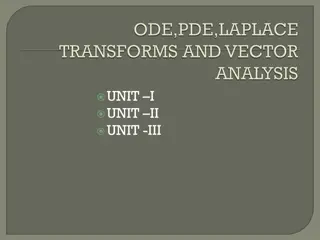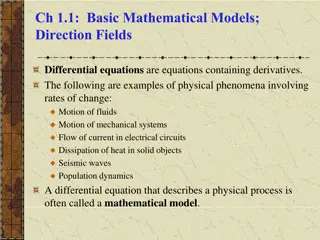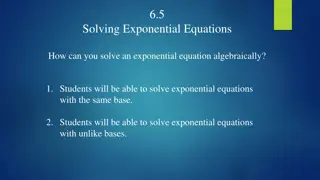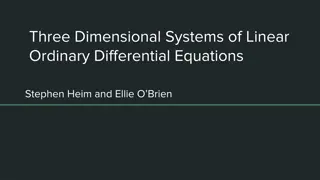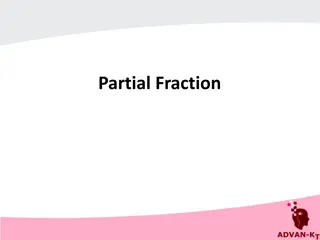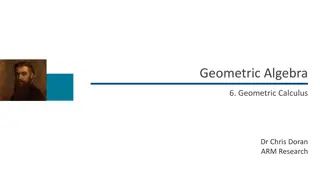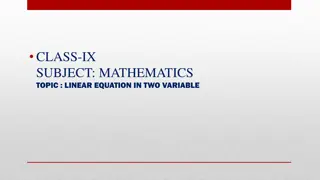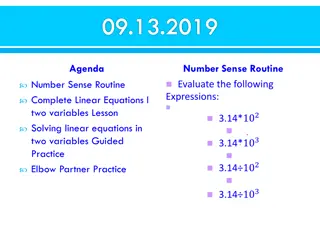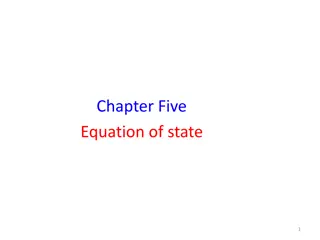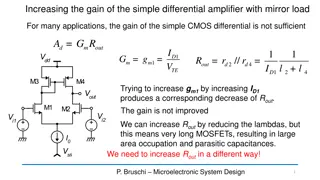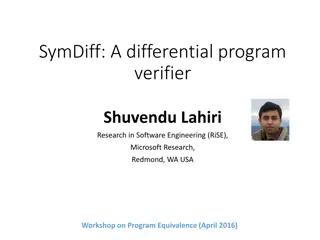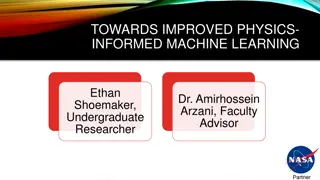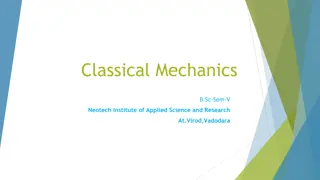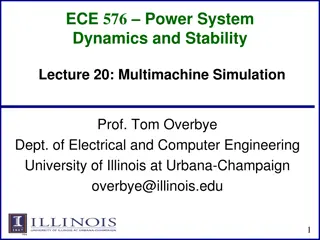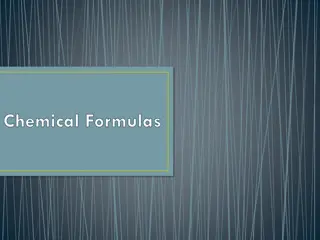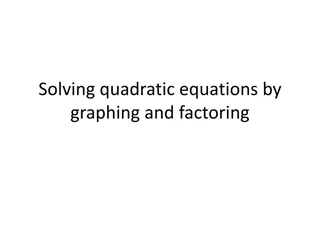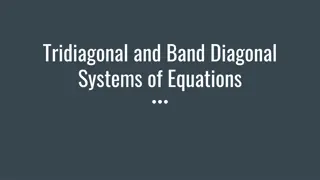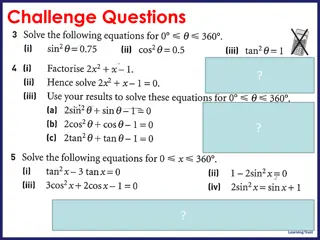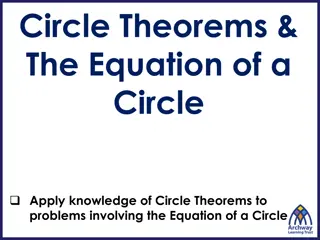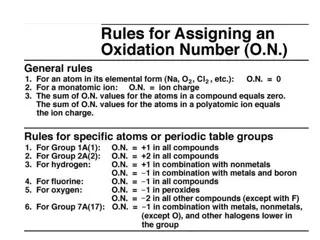Understanding Partial Differential Equations of Second Order
Exploring the concepts of second-order partial differential equations in mathematics, including the general form, linear equations with variable coefficients, and equations with constant coefficients. Learn about integral solutions, examples, and techniques for solving these equations with detailed explanations and illustrations.
Download Presentation

Please find below an Image/Link to download the presentation.
The content on the website is provided AS IS for your information and personal use only. It may not be sold, licensed, or shared on other websites without obtaining consent from the author. Download presentation by click this link. If you encounter any issues during the download, it is possible that the publisher has removed the file from their server.
E N D
Presentation Transcript
Submitted by: Dr.S.USHA ASST.PROFESSOR . DEPARTMENT OF MATHEMATICS
UNIT IV UNIT- V
PARTIAL DIFFERENTIAL EQUATIONS OF SECOND ORDER INTRODUCTION: An equation is said to be of order two, if it involves at least one of the differential coefficients r = (?2 z / ?2 x), s = (?2 z / ?x ?y), t =(?2 z / ?2 y), but now of higher order; the quantities p and q may also enter into the equation Thus the general form of a second order Partial differential equation is ?( ?, ?, ?, ?, ?, ?, ?,?) = 0 .. ...(1) The most general linear partial differential equation of order two in two independent variables x and y with variable coefficients is of the form ?? + ?? + ?? + ?? + ?? + ?? = ? ...... . (2) where ?, ?, ?, ?,?, ?, ? are functions of ? and ? only and not all ?, ?, ? are zero. E where 1(?) is an arbitrary function of ?. Integrating (2) w. r. t. we get ?? = ?3 + ? 1(?) + 2(?) where 2(y) is an arbitrary function of y.
Example: ?? = ?? Sol: Given equation can be written as ?2 ?/ ?? 2 = (1 /?) (?/?) ...(1) Integrating (1) w. r. t., ?, we get ??/ ?? = (?/ ? )( ?2/2) + 1(y) ..(2) where 1(y) is an arbitrary function of y Integrating (2) w. r. t.X, z = (?/ ?) 3/ 6 + x 1(y) + 2(y) w. r. t.Y we get ?? = ? 3 + ? 1(?) + 2(?) where 2(Y) is an arbitrary function of y.
[???? + ??1??1? + ??2??2? 2 + + ?1? ? ]?= 0 (3) or ?[ ?,? ]? = 0 Let ? = ?? + ?? be the part of the solution ?? = ??/ ?? = ?? ( ? + ??) ? 2 ? = ?2?/ ?? 2 = ?2? (? + ??) .. .. .. ... .. .. .. ... .. .. .. . And ? ? = ??/ ?? = ? ( ? + ??) ? 2? = ?2? /??2 = ? ( ? + ??) ... ... ... ... ... ... ... ... ... ... ... ? ?? = ??? /??? = ?? (? + ??) Substitute these values in (3),
we get ???? + ?? 1?? 1 + ?? 2?? 2 + . . . + ?1?? (? + ??) = 0 which is true if ? is a root of the equation If ?1 , ?2 , ?? , are distinct roots, then complementary functions is ? = ?1? + ?1? + ?2? + ?2? + . . . +??? + ??? where ?1 ,?2 , . . ., ?? are arbitrary functions. ? [?,? ] ? = 0 we replace ? by m and ? by 1 to get the auxiliary equation from which we get roots. w. r. t. ? ??/ ?? = 3?2 + 1(?) ....(2)
Partial differential equations with constant coefficients: We know that the general form of a linear partial differential equation An ( ???/ ??? ) + ?? 1?( ?? /??? 1 )?? + ?? 2 (???/ ??? 2 )??2 + + ?1( ???/ ??? )= ?( ?, ?) .. (1) Where the coefficients ?? , ?? 1 , ?? 2 , . . . , ?1 are constants or functions of ? and ?. If ??, ?? 1 , ?? 2 , . . . , ?1 are all constants, then (1) is called a linear partial differential equation with constant coefficients We denote ?/ ?? and ?/ ?? by ????? and ? ???? respectively. Therefore (1) can be written as [ ???? + ?? 1?? 1? + ?? 2?? 2? 2 + + ?1? ? ]? = ? (?, ?) (2) or ?[ ?,? ] ? = ?( ?, ?) The complementary function of (2)
Formal definition The Laplace transform of a function f(t), defined for all real numbers t 0, is the function F(s), which is a unilateral transform defined by where s is a complex number frequency parametewith real numbers and . An alternate notation for the Laplace transform is instead of F. The meaning of the integral depends on types of functions of interest. A necessary condition for existence of the integral is that f must be locally integrable on [0, ). For locally integrable functions that decay at infinity or are of exponential type, the integral can be understood to be a (proper) Lebesgue integral. However, for many applications it is necessary to regard it as a conditionally convergent improper integral at . Still more generally, the integral can be understood in a weak sense, and this is dealt with below. One can define the Laplace transform of a finite Borel measure by the Lebesgue integral[16] An important special case is where is a probability measure, for example, the Dirac delta function. In operational calculus, the Laplace transform of a measure is often treated as though the measure came from a probability density function f. ( E q . 1 )
Conditions For Applicability of Laplace Transform Laplace transforms are called integral transforms so there are necessary conditions for convergence of these transforms. i.e. f must be locally integrable for the interval [0, ) and depending on whether is positive or negative, e^(- t) may be decaying or growing. For bilateral Laplace transforms rather than a single value the integral converges over a certain range of values known as Region of Convergence.
Properties of Laplace Transform: Linearity Time Shifting
Time-reversal Differentiation in S-domain Convolution in Time
Initial Value Theorem Initial value theorem is applied when in Laplace transform the degree of the numerator is less than the degree of the denominator Inverse Laplace Transform Due to convergence characteristic Laplace transform also have an inverse transform. Laplace transforms exhibit one- to-one mapping from one function space to another. The formula for Inverse Laplace transform is;
How to Calculate Laplace Transform? Laplace transform makes the equations simpler to handle. When a higher order differential equation is given, Laplace transform is applied to it which converts the equation into an algebraic equation, thus making it easier to handle. Then we calculate the roots by simplification of this algebraic equation. Now inverse Laplace transform of simpler expression is found which solves the given higher order differential equation.
Applications of Laplace Transform Analysis of electrical and electronic circuits. Breaking down complex differential equations into simpler polynomial forms.Laplace transform gives information about steady as well as transient states. In machine learning, the Laplace transform is used for making predictions and making analysis in data mining. Laplace transform simplifies calculations in system modeling. Application of Laplace Transform In Signal Processing Laplace transforms are frequently opted for signal processing. Along with the Fourier transform, the Laplace transform is used to study signals in the frequency domain. When there are small frequencies in the signal in the frequency domain then one can expect the signal to be smooth in the time domain. Filtering of a signal is usually done in the frequency domain for which Laplace acts as an important tool for converting a signal from time domain to frequency domain.
Application of Laplace Transform In Control Systems Control systems are usually designed to control the behavior of other devices. Example of control systems can range from a simple home heating controller to an industrial control system regulates the behavior of machinery. Generally, control engineers use differential equations to describe the behavior of various closed loop functional blocks. Laplace transform is used here for solving these equations without the loss of crucial variable information. Characterization of Linear Time-Invariant Systems Using Laplace Transform For a casual system ROC associated with the system, the function is the right half plane. A system is anti-casual if its impulse response h(t) =0 for t > 0. If ROC of the system functions H(s) includes the j axis then the L.T.I. the system is called a stable system. If a casual system with rational system functions H(s) have negative real parts for all of its poles then the system is stable.
Inverse Laplace Transforms We are going to be given a transform, F(s), and ask what function (or functions) did we have originally. As you will see this can be a more complicated and lengthy process than taking transforms. In these cases we say that we are finding the Inverse Laplace Transform of F(s)and use the following notation. f(t)=L 1{F(s)} The Inverse Laplace Transform If L{f(t)} = F(s), then the inverse Laplace transform of F(s) is L 1 {F(s)} = f(t). (1)The inverse transform L 1 is a linear operator: L 1 {F(s) + G(s)} = L 1 {F(s)} + L 1 {G(s)}, (2) and L 1 {cF(s)} = cL 1 {F(s)}, (3) for any constant c
The convolution of functions f(t) and g(t) is (f g)(t) = Z t 0 f(t v)g(v) dv. As we showed in class, the convolution is commutative: (f g)(t) = 0 = 0 ?f(t v)g(v) dv ?g(t v)f(v) dv = (g f)(t). Applications of Inverse Laplace Transformation Introduction: The Laplace transformation is applied indifferent areas of science, engineering and technology. The Laplace transformation is applicable in so many fields. The Laplace Transform was primary used and named after by Pierre Simon Laplace Pierre Simon Laplace was a French Mathematician an Astronomer, who had a lot of control in the growth of several theories in mathematics, statistics, physics, and astronomy. He contributed seriously to physical mechanics, by converting the previous geometrical analysis to one based on calculus, which opened up application of his formulas to a wider range of problems. It is effective in solving linear differential equation either ordinary or partial. It reduces an ordinary differential equation into algebraic equation.
Applicationsof LaplaceTransforminScience and Engineering fields: 1. Analysis of electronic circuits: Laplace Transform is widely used by electronic engineers to solve quickly differential equations occurring in the analysis of electronic circuits. 2. System modeling: Laplace Transform is used to simplify calculations in system modeling, where large number of differential equations are used. 3. Digital signal processing: One can not imagine solving digital signal processing problems without employing Laplace Transform. 4. Nuclear Physics: In order to get the true form of radioactive decay a Laplace Transform is used. It makes easy to study analytic part of Nuclear physics possible. 5. Process Control: Laplace Transform is used for process controls. It helps to analyze the variables which when altered, produce desired manipulations in the result. Some of the examples in science and engineering fields in which Laplace Transforms are used to solve the differential equations occurred in this fields.The following examples highlights the importance of Laplace Transform in different engineering fields.
Second Shifting Theorem The Second Shifting Theorem of Laplace Transform states that if L[f(t)]= (s), then the Laplace Transform of thefollowing function, ?( )? = ?( ? ?) ????? > ????? (?) = 0 ????? < ?. Is expressed as L[g(t)]=? ?? (?) Multiplication of powers of the variable The variable that has been used so far is t . Thus, if we multiply powers of t with the original function f (t), The Laplace transform can be expressed as ????( ?) =( 1) ?(??/??? ) [ ?] Division of variable If L[f(t)]= (s), then the Laplace Transform when the function is divided by the variable can be expressed as ?[ ?( ?)] ? = (?)
IMPULSE FUNCTION (OR DIRAC DELTA FUNCTION) The impulse function is obtained by taking the limit of the rectangular pulse as its width, tw, goes to zero but holding the area under the pulse constant at one. Solution of ODEs by Laplace Transforms Procedure: Take the L of both sides of the ODE. Rearrange the resulting algebraic equation in the s domain to solve for the L of the output variable, e.g., Y(s). Perform a partial fraction expansion. Use the L-1 to find y(t) from the expression for Y(s).






